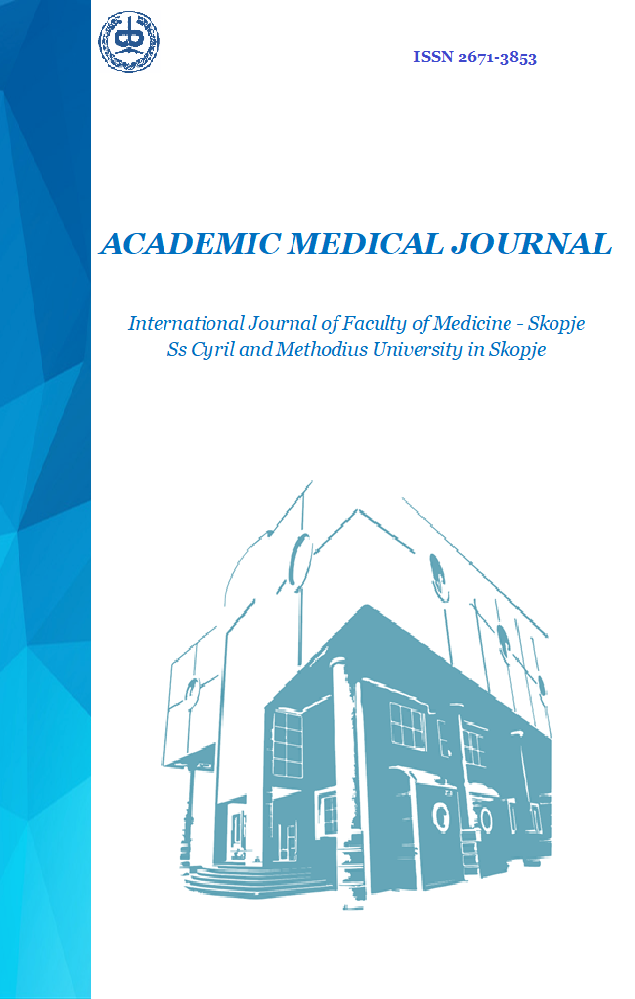COMPARATIVE EVALUATION OF VIDEO LARYNGOSCOPY AND CONVENTIONAL LARYNGOSCOPY DURING TRACHEAL INTUBATION
Keywords:
tracheal intubation, conventional laryngoscopy, video laryngoscopy, intubation techniquesAbstract
Introduction: Video laryngoscopy (VL) is relatively new technique, and has become a pivotal advancement in tracheal intubation, offering enhanced visualization of vocal cords and improving success rates.
Aim of the study: This study aimed to compare the efficacy of video laryngoscopy versus conventional laryngoscopy in adult patients requiring tracheal intubation for elective ENT surgeries.
Material and methods: This study involved 300 adult patients classified as ASA 1 and 2, aged 18 to 70, scheduled for elective ENT surgeries at a University Clinic in Skopje. Patients were divided into two groups: one underwent intubation using conventional Macintosh laryngoscopy, while the other utilized video laryngoscopy. Key parameters measured included intubation time, glottic visualization using the Cormack-Lehane score, number of intubation attempts, and instances of glottic trauma.
Results: The mean intubation time was significantly shorter in the VL group (26.09 seconds) compared to the ML group (34.01 seconds) (P < 0.001). The VL group exhibited superior glottic visualization, with 105 patients achieving Cormack-Lehane Score I versus 45 in the ML group (P = 0.001). Complications were notably lower in the VL group; only 3 instances of blood on the laryngoscope were reported compared to 10 in the ML group (P < 0.017).
Conclusion: Video laryngoscopy significantly enhances tracheal intubation success rates, reduces intubation time, and minimizes the risk of complications compared to conventional laryngoscopy, establishing it as a preferred technique in managing difficult airways.
References
Kumari M, Aastha, Kumari A, Bathla S, Sabharwal N, Das AK. Comparative Evaluation of C-MAC Videolaryngoscope with Macintosh Direct Laryngoscope in Patients with Normal Airway Predictors. Anesth Essays Res 2022; 16(3): 326-330. doi: 10.4103/aer.aer_78_22.
Bektaş H, Göksu S, Şen E. A Comparison of the Effectiveness of Videolaryngoscopy and Macintosh Laryngoscopy in Intubation Attempts on Adult Patients. Turk J Anaesthesiol Reanim 2022; 50(5): 352-357. doi: 10.5152/TJAR.2022.21367.
Nørskov AK, Wetterslev J, Rosenstock CV, Afshari A, Astrup G, Jakobsen JC, et al. Effects of using the simplified airway risk index vs usual airway assessment on unanticipated difficult tracheal intubation - a cluster randomized trial with 64,273 participants. Br J Anaesth 2016; 116(5): 680-689. doi: 10.1093/bja/aew057.
Gupta R, Gupta N, Kumar V, Garg R, Bharati SJ, Mishra S, et al. El-Ganzouri multivariate risk index based airway management in head and neck cancer patients: A retrospective analysis of 1000 patients in a tertiary care center. J Anaesthesiol Clin Pharmacol 2022; 38(1): 97-103. doi: 10.4103/joacp.JOACP_176_20.
Hazarika H, Saxena A, Meshram P, Kumar Bhargava A. A randomized controlled trial comparing CMac D Blade and Macintosh laryngoscope for nasotracheal intubation in patients undergoing surgeries for head and neck cancer. Saudi J Anaesth 2018; 12(1): 35-41. doi: 10.4103/sja.SJA_239_17.
El-Ganzouri AR, McCarthy RJ, Tuman KJ, Tanck EN, Ivankovich AD. Preoperative airway assessment: predictive value of a multivariate risk index. AnesthAnalg 1996; 82(6): 1197-1204. doi: 10.1097/00000539-199606000-00017.
Corso RM, Cattano D, Buccioli M, Carretta E, Maitan S. Post analysis simulated correlation of the El-Ganzouri airway difficulty score with difficult airway. Rev Bras Anestesiol 2016; 66(3): 298-303. doi: 10.1016/j.bjan.2016.02.007.
Caldiroli D, Cortellazzi P. A new difficult airway management algorithm based upon the El Ganzouri Risk Index and GlideScope® videolaryngoscope. A new look for intubation? Minerva Anestesiol 2011; 77(10): 1011-1017. PMID: 21610665.
Aziz MF, Dillman D, Fu R, Brambrink AM. Comparative effectiveness of the CMAC video laryngoscope versus direct laryngoscopy in the setting of the predicted difficult airway. Anesthesiology 2012; 116(3): 629-636. doi: 10.1097/ALN.0b013e318246ea34.
Abdallah SI, Gaballah KM. Endotracheal intubation criteria and stress response: airtraq versus macintosh laryngoscopes - a prospective randomized controlled trial. Anesth Essays Res 2019 ;13(3): 430-436. doi: 10.4103/aer.AER_80_19.
Zhu H, Liu J, Suo L, Zhou C, Sun Y, Jiang H. A randomized controlled comparison of non-channeled kingvision, McGrath MAC video laryngoscope and Macintosh direct laryngoscope for nasotracheal intubation in patients with predicted difficult intubations. BMC Anesthesiol 2019; 19(1): 166. doi: 10.1186/s12871-019-0838-z.
Cavus E, Neumann T, Doerges V, Moeller T, Scharf E, Wagner K, et al. First clinical evaluation of the C-MAC D-Blade videolaryngoscope during routine and difficult intubation. Anesth Analg 2011; 112(2): 382-385. doi: 10.1213/ANE.0b013e31820553fb.
Hoshijima H, Mihara T, Maruyama K, Denawa Y, Mizuta K, Shiga T, et al. C-MAC videolaryngoscope versus Macintosh laryngoscope for tracheal intubation: A systematic review and meta-analysis with trial sequential analysis. J Clin Anesth 2018; 49: 53-62. doi: 10.1016/j.jclinane.2018.06.007.
De-Xing Liu, Ying Ye, Yu-Hang Zhu, Jing Li, Hong-Ying He, Liang Dong, et al. Intubation of non-difficult airways using video laryngoscope versus direct laryngoscope: a randomized, parallel-group study. BMC Anesthesiol 2019; 19(1): 75. doi: 10.1186/s12871-019-0737-3.
Downloads
Published
Issue
Section
License
This work is licensed under CC BY 4.0 





